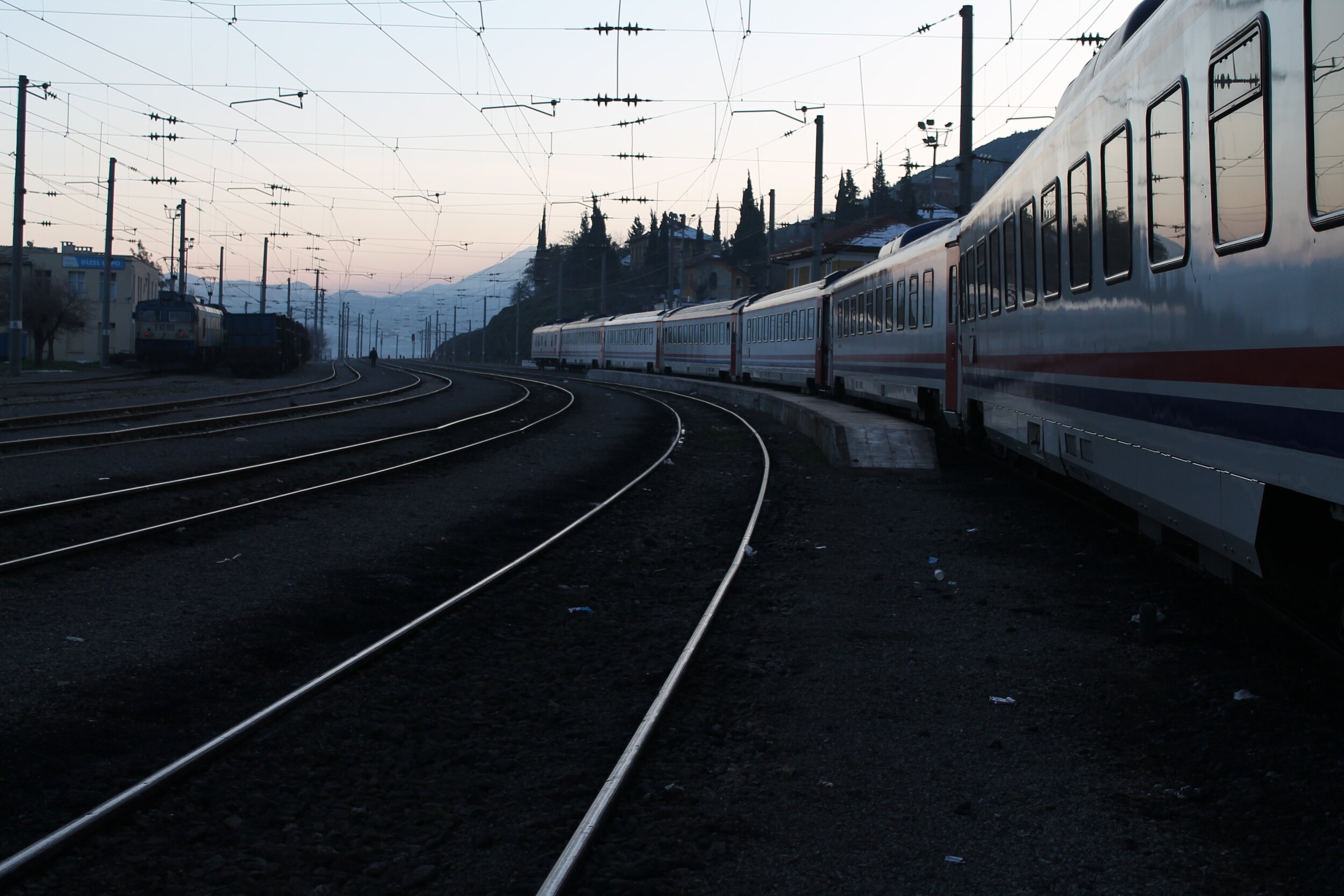Getting Around Morocco by Train
“The railway leaves you speechless and then it turns you into the storyteller.” - Anonymous
This is the third article in a series about transportation in Morocco.
Updated October 19, 2022
Early on in my Moroccan Arabic studies I was asked by my teacher to describe what it was like to ride the train in Morocco. My language abilities at that time were basic, and while I didn’t know how to say the word, “romantic” in Arabic, that is what I tried to describe. What is funny when I look back on this conversation is that I didn’t actually think riding the rails was romantic. Adventurous, yes…but romantic, no. I do think there is a literary appeal to railroads, giving them an air of romance. And maybe there are some train routes in the world that truly provide breathtaking, picturesque views. However, when I think about the Moroccan railroad system today, I am more drawn to its novelty and practicality.
Growing up in the United States, I had never taken a train as a means of transportation over long distances. My experience was the same in South America. Granted, I have ridden trains that are connected to larger metro systems, like in New York City, Paris, and Buenos Aires, and the transportation nerd that I am is really impressed by the connectedness of these systems. But prior to moving to Morocco, I had never ridden trains that crossed entire states and countries. Herein lies the appeal of the railroad network in Morocco, that can take you to many places across the country.
When we first arrived in Morocco we moved to Fes to start learning Moroccan Arabic. Because we had friends living in Tangier, we found ourselves taking weekend trips fairly frequently to visit them. For about $40 roundtrip per person, we could leave Fes on Friday afternoon, travel less than four hours to Tangier, enjoy our weekend on the Mediterranean Sea, and return in time for our class on Monday morning. The city of Fes did not have a Starbucks, so one of the appeals to this trip was our layover in Kenitra; during our 20-minute stop, we would quickly order drinks from Starbucks and then hop onto the newly christened fast train, Al-Boraq. Fifty minutes later we would pull into the newly constructed (or at least freshly remodeled) Tangier train station, greeted by interior palm trees and yet another Starbucks (which we did not frequent until our departure at the end of the weekend).
For me, riding the rails in Morocco is probably my favorite means of transportation in the country.
The train network can get you to most major cities on the coastal side of the Atlas Mountains, from Marrakech in the South, all the way to Tangier in the North, and Oujda and Nador in the East. If you ever visit the country of Morocco, perhaps you will have the opportunity to experience the train. If you do visit, here are some tips to keep in mind.
How to Take the Train in Morocco
Website - The railroad is called ONCF and has a very helpful website. I typically use the website to give me an idea of train schedules and prices. There is an option to buy tickets online, and this has become my preferred method of purchase. You may only have success paying with a Moroccan card. One of the downsides of the website is that it is not easy to find a route map of the country; I actually spent a decent amount of time searching the website for a route map and could not find an exhaustive one. I have, however, seen route maps posted in some stations, though.
Buying tickets - At the train station, there are typically two ways to buy tickets. All train stations will have a ticket vendor, and if you wait in line, you will eventually talk to this person and explain where you want to travel and at what time. The second option is to purchase a ticket at a ticket machine (kiosk). This is my preferred method because it allows me to see the prices for First and Second class, as well as the various departure times. Unfortunately these kiosks are often not working, so it is hit or miss whether you can use them. A red light means the machine is not working, and a green light means that it is. You can select language options in English and French on the touch screen.You used to be able to pay in cash at these kiosks, but now you are required to use a card; I have only had success paying with a Moroccan bank card.
First vs Second class - When buying a ticket, you will have the option between First and Second class. Sometimes there is very little difference in price between the two. The experience in those classes will depend on what route you are taking. Oftentimes, regardless of ticket class, you will find yourself in a compartment with other people. In Second class, there will be eight passengers in this compartment, and in First class, there will be six passengers in the same amount of space. The luggage will go on the shelf above your head. On other trains, you will find seats more typical of an airplane, with all of the passengers facing one direction in one train car. Sometimes you will be assigned to a seat, and other times you will not be; this also depends on the route. Your ticket actually contains a lot of useful information. Check out this page to see what info you will find on it. On Al-Boraq, even the Second class seats are very nice.
Al-Boraq - This is the high speed train that runs between Casablanca and Tangier, with stops in Rabat and Kenitra. It takes just over two hours to travel between Casa and Tangier, with roundtrip tickets in Second class costing less than $50 per person. My wife and I really enjoy riding the high speed train. It is very modern, which is an interesting contrast to some of the more traditional elements of Morocco. There are future plans to expand the high speed train network to more cities like Marrakech and Fes.
Connection to buses - While I have never done so, it is possible to buy connecting tickets to buses. ONCF operates with Supratours to connect to some cities not serviced by the railroad. I have been told that sometimes these connecting buses are found in the same stations as the trains, but I cannot speak from experience.
Bathrooms - If you need to use the restroom, it is advisable to do so before entering the train. Bathrooms on the train may be less sanitary than what you are used to; although this could also be said about the bathrooms in the train station themselves. More often than not, though, you will have a cleaner experience using the station bathroom than the train bathroom. Take your own paper with you, as it is not guaranteed to be provided, and also don’t be surprised if the station bathroom is without a seat and/or without a bowl (aka a squatty potty).
Train stations - The country of Morocco has invested significant money to upgrade their train stations, at least in the major cities. Many of the stations contain Starbucks (which may be important to some of you!), as well as McDonald’s. Inside of the train station you will notice a reader board with information about upcoming trains; the information is provided in Arabic and French. In general, do not expect a lot of free seating options while you wait for your train; recently in the Fes and Casablanca stations, I was surprised by how few places there were to sit. As a result, I ordered ice cream from a local restaurant and sat in their booth. When you have arrived at your destination and are leaving the station, be mindful of the taxi drivers who are looking to charge higher prices to tourists. If you don’t mind paying more, then you can entertain their offer. However, if you want to pay the local price, then continue walking until you get to the street, and find a taxi there.
Miscellaneous Items - While you are on the train, from time to time you will hear a “click, click, click” as a food cart rolls down the aisle. You can purchase sandwiches, chips, beverages, and other snack items. During Ramadan, you may be provided with water and dates so that all the Muslim passengers can break the fast together. Finally, during the summer months you may find that the train compartments get very hot as ventilation is poor. Even if the window is cracked open, you may feel stuffy. There isn’t much you can do about this other than to be expecting it.
I hope that your experience riding the trains in Morocco is adventurous for all of the right reasons!
Are you visiting Morocco soon? Start your travels with us to learn some Moroccan Arabic phrases and cultural dos and don’t and to have the best trip available to you.








“What have we gotten ourselves into?” I asked myself as our car scraped the rocks beneath us. We were traversing a dried river bed in search of our lodging for the night, and my mind was racing to the reaction of the rental car company when we returned the car in a few days. “How much is it going to cost if we total the vehicle?” I continued wondering.